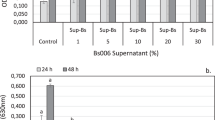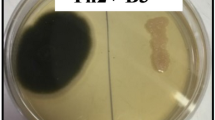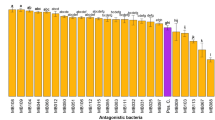Abstract
Fusarium oxysporum Schlecht. (Hypocreales: Nectriaceae) is one of the most devastating plant pathogens worldwide, causing vascular wilt in several crops. Management of this disease primarily relies on chemical fungicides and resistant cultivars in high value crops. However, due to the limited efficacy of these methods, alternative control methods are needed. Biological control is a sustainable, safe, and effective alternative, but the use of a single biological control agent (BCA) usually has inconsistent results. The consistency of biocontrol could be enhanced using microbial consortia. In this context, the aim of this work was to select an effective microbial consortium against vascular wilt in cape gooseberry (Physalis peruviana L.) caused by Fusarium oxysporum f. sp. physali, from a mixture of four strains of Trichoderma spp. Pers. (Hypocreales: Hypocraceae) and Bacillus velezensis (Bacillales: Bacillaceae) Bs006. The calculated synergy factor was used as a selection criterion. Then the selected consortium was evaluated in the field and compared to carbendazim. The Trichoderma virens Gl006 and B. velezensis Bs006 consortium showed synergistic activity against vascular wilt under greenhouse and field conditions and efficacy similar to chemical control. These results suggest that Gl006 and Bs006 have a higher potential in controlling Fusarium wilt in cape gooseberry when applied as a consortium compared to separate, single strains.


Similar content being viewed by others
References
Abbott WS (1925) A method of computing the effectiveness of an insecticide. J Econ Entomol 18:265–267
ANALDEX (2019) Informe de exportaciones de Fruta. https://www.analdex.org/2019/07/31/informe-de-exportaciones-de-fruta-enero-mayo-2019
Ávila-Orozco FD, León-Gallón LM, Pinzón-Fandiño MI, Londoño-Orozco A, Gutierrez-Cifuentes JA (2017) Residualidad de fitosanitarios en tomate y uchuva cultivados en Quindío (Colombia). Corpoica Cienc y Tecnol Agropecu 18:571–582
Bai N, Wang S, Abuduaini R, Zhang M, Zhu X, Zhao Y (2017) Rhamnolipid-aided biodegradation of carbendazim by Rhodococcus sp. D-1: characteristics, products, and phytotoxicity. Sci Total Environ 15:590–591
Beltrán CR, Cotes AM, París A (2007) Selection of isolates of Trichoderma spp. with biocontrol activity over Rhizoctonia solani in potato. IOBC/WPRS Bull 30:55–58
Bhatia SK, Bhatia RK, Choi YK, Choi YK, Kan E, Kim YU, Yang YH (2018) Biotechnological potential of microbial consortia and future perspectives. Crit Rev Biotechnol 38:1209–1229
Brimner TA, Boland GJ (2003) A review of the non-target effects of fungi used to biologically control plant diseases. Agric Ecosyst Environ 100:3–16
Bunterngsook B, Mhuantong W, Champreda V, Thamchaipenet A, Eurwilaichitr L (2014) Identification of novel bacterial expansins and their synergistic actions on cellulose degradation. Bioresour Technol 159:64–71
Colby SR (1967) Calculating synergistic and antagonistic responses of herbicide combinations. Weeds 15:20–22
Cotes AM (2018) Control biológico de fitopatógenos, insectos y ácaros, vol 1. Corporación Colombiana de Investigación Agropecuaria (Agrosavia), Mosquera
Cotes AM, Moreno-Velandia CA, Molano LF (2007) Prospects for integrated management of Sclerotinia sclerotiorum in lettuce. IOBC/WPRS Bull 30:391–394
Cotes AM, Jiménez P, Rodríguez MX, Zapata JA, Gómez M, Grijalba E, González C, Smith A, Mejía C, Mesa P, Cruz LC (2012). In: Diaz A (ed) Estrategias de control biológico de Fusarium oxysporum en el cultivo de la Uchuva (Physalis peruviana). Corpoica, Bogotá
Cotes AM, Moreno-Velandia CA, Espinel C, Villamizar L, Gómez M (2018) Biological control of tomato Fusarium wilt and whiteflies with two fungal biopesticides. Acta Hortic 1207:129–137
Curi PN, Carvalho CDS, Salgado DL, Pio R, da Silva DF, Pinheiro AC, de Souza V (2018) Characterization of different native American Physalis species and evaluation of their processing potential as jelly in combination with brie-type cheese. Food Sci Technol 38:112–119
Díaz A, Smith S, Mesa P, Zapata J, Caviedes D, Cotes AM (2013) Control of Fusarium wilt in cape gooseberry by Trichoderma koningiopsis and PGPR. IOBC/WPRS Bull 86:89–94
Estevez De Jensen C, Percich JA, Graham PH (2002) Integrated management strategies of bean root rot with Bacillus subtilis and Rhizobium in Minnesota. Fields Crop Res 74:107–115
Fan B, Blom J, Klenk HP, Borriss R (2017) Bacillus amyloliquefaciens, Bacillus velezensis, and Bacillus siamensis form an “Operational Group B. amyloliquefaciens” within the B. subtilis species complex. Front Microbiol 8:22
Galeana-Sánchez E, Sánchez-Rangel D, de la Torre-Hernández ME, Nájera-Martínez M, Ramos-Villegas P, Plasencia J (2017) Fumonisin B1 produced in planta by Fusarium verticillioides is associated with inhibition of maize β-1,3-glucanase activity and increased aggressiveness. Physiol Mol Plant Pathol 100:75–83
Guetsky R, Shtienberg D, Elad Y, Fischer E, Dinoor A (2002) Improving biological control by combining biocontrol agents each with several mechanisms of disease suppression. Phytopathology 92:976–985
Harman GE, Howell CR, Viterbo A, Chet I, Lorito M (2004) Trichoderma species—opportunistic, avirulent plant symbionts. Nat Rev Microbiol 2:43–56
Hervás A, Landa B, Datnoff LE, Jiménez-Díaz RM (1998) Effects of commercial and indigenous microorganisms on Fusarium wilt development in chickpea. Biol Control 13:166–176
Izquierdo-García LF, González-Almario A, Cotes AM, Moreno-Velandia CA (2020) Trichoderma virens Gl006 and Bacillus velezensis Bs006: a compatible interaction controlling Fusarium wilt of cape gooseberry. Sci Rep 10:1–13
Jain A, Singh A, Singh S, Singh HB (2015) Biological management of Sclerotinia sclerotiorum in pea using plant growth promoting microbial consortium. J Basic Microbiol 55:961–972
Lazarovits G, Turnbull A, Johnston-Monje D (2014) Plant health management: biological control of plant pathogens. Elsevier, London
Levy Y, Benderly M, Cohen Y, Gisi U, Bassand D (1986) The joint action of fungicides in mixtures; comparison of two methods for synergy calculation. EPPO Bull 16:651–657
McGovern RJ (2015) Management of tomato diseases caused by Fusarium oxysporum. Crop Prot 73:78–92
Moreno-Velandia CA (2017) Interactions between Bacillus amyloliquefaciens Bs006, Fusarium oxysporum Map5 and Cape gooseberry (Physalis peruviana). Universidad Nacional de Colombia, Bogotá
Moreno-Velandia CA, Cotes AM (2010) Desarrollo de un bioplaguicida a base de Trichoderma koningiopsis Th003 y uso en el cultivo de lechuga para el control del moho blanco (Sclerotonia scleortiorum y Sclerotinia minor). Corpoica, Bogotá
Moreno-Velandia CA, Cotes AM, Guevara E (2007) Biological control of foliar diseases in tomato greenhouse crop in Colombia: selection of antagonists and efficacy tests. IOBC/WPRS Bull 30:59–62
Moreno-Velandia CA, Castillo F, González A, Bernal D, Jaimes Y, Chaparro M, González C, Rodriguez F, Restrepo S, Cotes AM (2009) Biological and molecular characterization of the response of tomato plants treated with Trichoderma koningiopsis. Physiol Mol Plant Pathol 74:111–120
Moreno-Velandia CA, Izquierdo-García LF, Ongena M, Kloepper JW, Cotes AM (2019) Soil sterilization, pathogen and antagonist concentration affect biological control of Fusarium wilt of cape gooseberry by Bacillus velezensis Bs006. Plant Soil 435:39–55
Moreno-Velandia CA, Ongena M, Cotes AM (2021) Effects of fengycins and iturins on Fusarium oxysporum f.sp. physali and root colonization by Bacillus velezensisBs006 protect golden berry against vascular wilt. Phytopathology (Accepted)
National Center for Biotechnology Information (2005) PubChem Carbendazim, CID=25429. https://pubchem.ncbi.nlm.nih.gov/compound/Carbendazim. Accessed 25 Apr 2020
Ongena M, Jacques P (2008) Bacillus lipopeptides: versatile weapons for plant disease biocontrol. Trends Microbiol 16:115–125
Paerl HW, Pinckney JL (1996) A mini-review of microbial consortia: Their roles in aquatic production and biogeochemical cycling. Microb Ecol 31:225–247
Panda J, Kanjilal T, Sumona D (2017) Optimized biodegradation of carcinogenic fungicide Carbendazim by Bacillus licheniformis JTC-3 from agro-effluent. Biotechnol Res Innov 2:45–57
Parikh L, Eskelson MJ, Adesemoye AO (2018) Relationship of in vitro and in planta screening: improving the selection process for biological control agents against Fusarium root rot in row crops. Arch Phytopathol Plant Prot 51:156–169
Raupach GS, Kloepper JW (1998) Mixtures of plant growth-promoting rhizobacteria enhance biological control of multiple cucumber pathogens. Phytopathology 88:1158–1164
Saravanakumar K, Yu C, Dou K, Wang M, Li Y, Chen J (2016) Synergistic effect of Trichoderma-derived antifungal metabolites and cell wall degrading enzymes on enhanced biocontrol of Fusarium oxysporum f. sp. cucumerinum. Biol Control 94:37–46
Sarma BK, Yadav SK, Singh S, Singh HB (2015) Microbial consortium-mediated plant defense against phytopathogens: readdressing for enhancing efficacy. Soil Biol Biochem 87:25–33
Shaner G, Finney RE (1977) The effect of nitrogen fertilization on the expression of slow-mildewing resistance in Knox wheat. Phytopathology 67:1051–1056
Siegel-Hertz K, Edel-Hermann V, Chapelle E, Terrat S, Raaijmakers JM, Steinberg C (2018) Comparative microbiome analysis of a Fusarium wilt suppressive soil and a Fusarium wilt conducive soil from the Châteaurenard region. Front Microbiol 9:568
Simbaqueba J, Catanzariti AM, González C, Jones DA (2018) Evidence for horizontal gene transfer and separation of effector recognition from effector function revealed by analysis of effector genes shared between cape-gooseberry- and tomato-infecting formae speciales of Fusarium oxysporum. Mol Plant Pathol 19:2302–2318
Simbaqueba J, Rodríguez EA, Burbano-David D, González C, Caro-Quintero A (2021) Putative novel effector genes revealed by the genomic analysis of the phytopathogenic fungus Fusarium oxysporum f. sp. physali (Foph) that infects cape gooseberry plants. Front Microbiol 11:593915
Singh A, Mehta S, Singh HB, Nautiyal CS (2003) Biocontrol of collar rot disease of betelvine (Piper betle L.) caused by Sclerotium rolfsii by using rhizosphere-competent Pseudomonas fluorescens NBRI-N6 and P. fluorescens NBRI-N. Curr Microbiol 47:153–158
Sundaramoorthy S, Raguchander T, Ragupathi N, Samiyappan R (2011) Combinatorial effect of endophytic and plant growth promoting rhizobacteria against wilt disease of Capsicum annum L. caused by Fusarium solani. Biol Control 60:59–67
Sylla J, Alsanius BW, Krüger E, Becker D, Wohanka W (2013) In vitro compatibility of microbial agents for simultaneous application to control strawberry powdery mildew (Podosphaera aphanis). Crop Prot 51:40–47
Toloza-Moreno DL, Lizarazo-Forero LM, Uribe-Vélez D (2020) Antagonist capacity of bacteria isolated from cape gooseberry cultures (Physalis peruviana L.) for biological control of Fusarium oxysporum. Trop Plant Pathol 45:1–12
Urrea R, Cabezas L, Sierra R, Cárdenas M, Restrepo S, Jiménez P (2011) Selection of antagonistic bacteria isolated from the Physalis peruviana rhizosphere against Fusarium oxysporum. J Appl Microbiol 111:707–716
Vestberg M, Kukkonen S, Saari K, Parikka P, Huttunen J, Tainio L, Devos N, Weekers F, Kevers C, Thonart P, Lemoine M, Cordier C, Alabouvette C, Gianinazzi S (2004) Microbial inoculation for improving the growth and health of micropropagated strawberry. Appl Soil Ecol 27:243–258
Vinale F, Sivasithamparam K, Ghisalberti EL, Marra R, Woo SL, Lorito M (2008) Trichoderma–plant–pathogen interactions. Soil Biol Biochem 40:1–10
Weller D (1988) The rhizosphere with bacteria. Ann Rev Phytopathol 26:379–407
Xu J, He J, Wang Z, Wang K, Li WJ, Tang SK, Li SP (2007) Rhodococcus qingshengii sp. nov., a carbendazim-degrading bacterium. Int J Syst Evol Microbiol 57:2754–2757
Xu X-M, Jeffries P, Pautasso M, Jeger MJ (2011) Combined use of biocontrol agents to manage plant diseases in theory and practice. Phytopathology 101:1024–1031
Yang R, Fan X, Cai X, Hu F (2015) The inhibitory mechanisms by mixtures of two endophytic bacterial strains isolated from Ginkgo biloba against pepper Phytophthora blight. Biol Control 85:59–67
Yu Y, Chu X, Pang G, Xiang Y, Fang H (2009) Effects of repeated applications of fungicide carbendazim on its persistence and microbial community in soil. J Environ Sci 21:179–185
Zhang S, Merino N, Okamoto A, Gedalanga P (2018) Inter-kingdom microbial consortia mechanisms to guide biotechnological applications. Microb Biotechnol 11:833–847
Acknowledgements
This work was carried out with the financial support from Ministerio de Agricultura y Desarrollo Rural—MADR through Tv15 and Tv16 transference resources to Corporación Colombiana de Investigación Agropecuaria—AGROSAVIA, Project 687. The pathogenic strain of F. oxysporum f. sp. physali Map5 as well as the biocontrol strains Gl006, Th003, Th034, Th035 and Bs006 from AGROSAVIA Microorganisms Working-Collection were evaluated in the research that gave rise to this paper.
Author information
Authors and Affiliations
Contributions
AMC, CAMV and LFIG Conceived the research idea, LFIG and CAMV: Carried out the experiments, LFIG: Drafted the manuscript under advice of CAMV. LFIG, CAMV and AMC: Contributed to analyzed data and critical revising and approval the final version of the manuscript.
Corresponding author
Ethics declarations
Conflict of interest
The authors declare no conflicts of interest.
Additional information
Handling Editor: Jesus Mercado Blanco.
Supplementary Information
Below is the link to the electronic supplementary material.
Rights and permissions
About this article
Cite this article
Izquierdo-García, L.F., Cotes, A.M. & Moreno-Velandia, C.A. Screening for effective microbial consortia against Fusarium wilt of cape gooseberry (Physalis peruviana). BioControl 66, 713–725 (2021). https://doi.org/10.1007/s10526-021-10095-6
Received:
Accepted:
Published:
Issue Date:
DOI: https://doi.org/10.1007/s10526-021-10095-6




